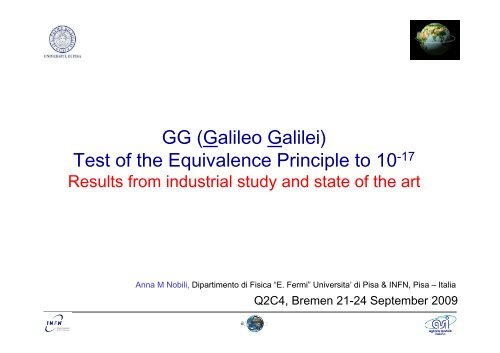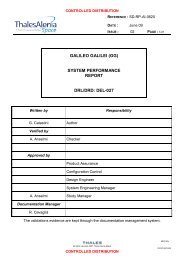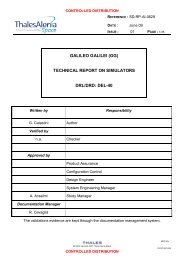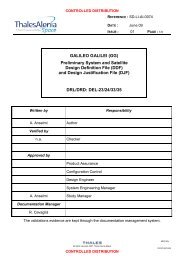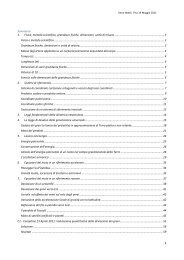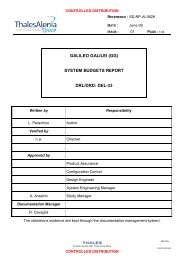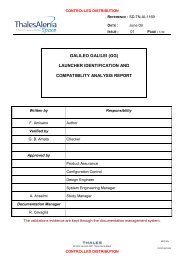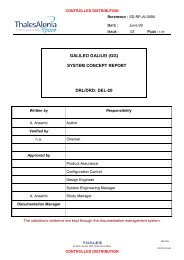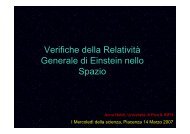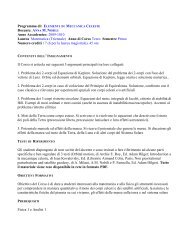GG (Galileo Galilei) Test of the Equivalence Principle to 10-17
GG (Galileo Galilei) Test of the Equivalence Principle to 10-17
GG (Galileo Galilei) Test of the Equivalence Principle to 10-17
Create successful ePaper yourself
Turn your PDF publications into a flip-book with our unique Google optimized e-Paper software.
<strong>GG</strong> (<strong>Galileo</strong> <strong>Galilei</strong>)<strong>Test</strong> <strong>of</strong> <strong>the</strong> <strong>Equivalence</strong> <strong>Principle</strong> <strong>to</strong> <strong>10</strong> -<strong>17</strong>Results from industrial study and state <strong>of</strong> <strong>the</strong> artAnna M Nobili, Dipartimen<strong>to</strong> di Fisica “E. Fermi” Universita’ di Pisa & INFN, Pisa – ItaliaQ2C4, Bremen 21-24 September 2009
<strong>GG</strong> differential accelerometer (I)NOTE: We do not fly a vacuum chamber (use venting <strong>to</strong> space instead..)
<strong>Test</strong> masses material choice in <strong>GG</strong> (I)Co-rotation makes many disturbing effects DC. <strong>Test</strong> masses do not need <strong>to</strong> be manufactured<strong>to</strong> very high precision => More freedom in <strong>the</strong> choice <strong>of</strong> materials <strong>to</strong> maximize chance <strong>of</strong>EP violation and significance <strong>of</strong> testEP violation not expected <strong>to</strong> depend on macroscopic properties <strong>of</strong> matter (density,chemical, mechanical, electric or magnetic characteristics)Barion number, Lep<strong>to</strong>n number and z component <strong>of</strong> Isospin (normalized <strong>to</strong> mass in unit <strong>of</strong><strong>the</strong> mass <strong>of</strong> H a<strong>to</strong>m) have been identified (Fischbach & Talmadge, 1998)B/ µ L/ µ I z/ µ=> choose test masses materials so as <strong>to</strong> maximize difference in all 3 <strong>the</strong>se properties!
<strong>Test</strong> masses material choice in <strong>GG</strong> (III)HDPE (High Density Polyethylene) identified – <strong>to</strong> be tested in <strong>GG</strong>G (has interesting sideconsequences.. Not conductive, capacitance read-out possible without capacitance plates inbetween test cylinders … differential by definition .. )
<strong>GG</strong> lock/unlock mechanisms1. Mechanical s<strong>to</strong>ps2. Launch safe lock/unlock (non magnetic actua<strong>to</strong>rs)3. Fine lock/unlock (inch-worm actua<strong>to</strong>rs)Designed by DTMTechnologies (Ferrari)Lock/unlock <strong>of</strong> inner test cylinder“bunny ear” lock/unlock <strong>of</strong>coupling arm
Drivers and requirements: some numbers (I)
Drivers and requirements: somenumbers (II)
Drivers and requirements: some numbers (III)
Drivers and requirements: some numbers (IV)
Drivers and requirements: some numbers (V)
Drivers and requirements: some numbers (VI)…passive MLI sufficient
Drivers and requirements: some numbers (VII)Electric charging & patch effects:• passive electric grounding <strong>of</strong> <strong>the</strong> test masses• co-rotation <strong>of</strong> <strong>the</strong> test masses and <strong>the</strong> capacitance transdusers (make patch effectsDC or slowly varying if <strong>the</strong>y do slowly vary.. .as <strong>the</strong>y do…)• gold coating• direct measurement <strong>of</strong> <strong>the</strong> effects <strong>of</strong> any patches <strong>of</strong> charges on test masses, as wehave done in <strong>GG</strong>G (see later..)
Error budget (I)How it is builtEstablish requirementsImplement Drag Free ControlRun <strong>GG</strong> Simula<strong>to</strong>rHeritage from GOCE!Analyze time his<strong>to</strong>ry <strong>of</strong> test masses relative displacementsSingle out systematic effects and check <strong>the</strong>ir magnitude and signature
Error budget (II)
A simula<strong>to</strong>r in <strong>the</strong> lab: “<strong>GG</strong> on <strong>the</strong> Ground (<strong>GG</strong>G)”Same number <strong>of</strong> degrees <strong>of</strong> freedom; same dynamical properties; position <strong>of</strong> relativeequilibrium <strong>of</strong> <strong>the</strong> test masses in <strong>the</strong> horizontal plane is NOT stabilized by local gravity (as itshould be as a test <strong>of</strong> experiment in space…)<strong>GG</strong>G lab at INFN Pisa-San Piero a Grado
<strong>GG</strong>G sensitivity: major improvements (I)FFT <strong>of</strong> relative displacements <strong>of</strong> <strong>GG</strong>G test cylinders in <strong>the</strong> horizontal, not rotating, plane <strong>of</strong> lab
<strong>GG</strong>G sensitivity: major improvements (II)PSD <strong>of</strong> relative displacements <strong>of</strong> <strong>GG</strong>G test cylinders in <strong>the</strong> horizontal, not rotating, plane <strong>of</strong> lab
<strong>GG</strong>G current sensitivity <strong>to</strong> EP violation in <strong>the</strong> field <strong>of</strong> <strong>the</strong> Sun<strong>GG</strong>G has measured 6x<strong>10</strong> -9 m at diurnal frequency with coupling period <strong>of</strong> 13 s =>η sun ~2.3x<strong>10</strong> -7Limited by terrain tilts: apparatus not suspended, active tilt control only.Main issue: tilt sensors dependence on temperature
s<strong>GG</strong>G (suspended <strong>GG</strong>G) - ASI funds (I)New chamber+ new ro<strong>to</strong>r(undercompletion)New chamber has <strong>the</strong> right symmetry and has been designed <strong>to</strong> minimize disturbances on <strong>GG</strong>Gs<strong>GG</strong>G will be suspended inside chamber by cardanic joint (not rotating) <strong>to</strong> reduce low frequency terrain tiltspassively, in addition <strong>to</strong> active tilt control now in use (Note: active tilt control is limited by <strong>the</strong>rmal effects on tiltsensor and requires good <strong>the</strong>rmal stabilization <strong>to</strong> be effective)An Experiment Simula<strong>to</strong>r will be built by Thales Alenia Space-Italy for <strong>the</strong> new <strong>GG</strong>G, similarly <strong>to</strong> <strong>the</strong> Simula<strong>to</strong>rbuilt for <strong>the</strong> space experiment, <strong>to</strong> be compared with experimental measurements …
s<strong>GG</strong>G (suspended <strong>GG</strong>G) – ASI funds (II)• With <strong>the</strong> cardanic suspension already manufactured we expect a terrain tilt reduction at low frequencies byabout 5000 (exploit lever effect…)• With active terrain tilt control (+<strong>the</strong>rmal stabilization) plus passive attenuation we expect <strong>to</strong>detect 1 pm displacements (<strong>GG</strong> target is 0.5 pm) i.e., with current natural test massesperiod <strong>of</strong> 13 s: => η sun ~4x<strong>10</strong> -11Longer natural period possible (sensitivity would increassequadratically..) but shall we encounter <strong>the</strong> mo<strong>to</strong>r ball bearingsnoise???
Thermal stability in new chamberThermal stability <strong>of</strong> tiltmeter inside chamber (multi stage <strong>the</strong>rmal control): <strong>to</strong> a few tenths<strong>of</strong> mdeg down at diurnal frequency (requires 20 mW only)
A better tiltmeter <strong>to</strong> improve active tilt control?Double pendulum (one simple + oneinverted, aligned, coupled by tinycantilever), based on knife edgesuspensions.Capacitance transducer with ad hocelectronic board developed in <strong>the</strong> labbased on <strong>the</strong> AD7745 24 bit capacitance<strong>to</strong> digital converter capable <strong>to</strong> measureup <strong>to</strong> 4 picoFarad <strong>to</strong> a few tenths <strong>of</strong>fem<strong>to</strong>Farad. No additional electronics isneeded outside <strong>the</strong> vacuum chamber;data are transferred <strong>to</strong> <strong>the</strong> computeroutside via USB port.Designed <strong>to</strong> reach <strong>10</strong>0 s period(equivalent <strong>to</strong> a simple pendulum2500 m long!!!) .. Extremelysensitive…On first tests (only rough adjustment <strong>of</strong>period and alignment) we havemeasured 34.8 s period (equivalent <strong>to</strong> a300 m simple pendulum..)
Measurement <strong>of</strong> electric patch effects (I)Apply a force <strong>to</strong> <strong>the</strong> external test cylinder with acapacitance plate (both grounded)Since outer and inner test cylinders are coupled, <strong>the</strong>ywill move relative <strong>to</strong> each o<strong>the</strong>rTheir differential motion is measured by <strong>the</strong>capacitance bridges (main sensors) located inbetween <strong>the</strong> test cylinders
Measurement <strong>of</strong> electric patch effects (II)FV=o2Q2εSCharge changes sign with applied potential, patchcharge does not!First, apply unipolar potential and measure effect onTMs; <strong>the</strong>n switch <strong>to</strong> bipolar potential and measureeffect on TMs (square wave with same period…)∆x∆y+ V+ V 0.75µm 0.18µm
Measurement <strong>of</strong> electric patch effects (III)2QqF± V ≡ Fpatch= qε Sodisplacement q± patch VV= 4 = 4displacement Q V+ V + V + Vis <strong>the</strong> charge <strong>of</strong> patch we want <strong>to</strong> measurepatchby measuring <strong>the</strong>displacements in <strong>the</strong> twocases we measure V patch …∆x∆y± V± V 0.0275 µ m 0.006 µ mFrom <strong>the</strong>semeasurements:Vpatch 0.3V(Plate made <strong>of</strong> Al liketest cylinders, no goldcoating…. )
Measurement <strong>of</strong> electric patch effects (III)• No modeling needed, very meat measurement• You measure directly <strong>the</strong> effect <strong>of</strong> patch charges on <strong>the</strong> tests masses• We have done with <strong>GG</strong>G spinning for <strong>10</strong>.6 d, <strong>to</strong> measure time variation <strong>of</strong> patch effectamplitude….Note: <strong>the</strong> effect <strong>of</strong> <strong>the</strong> patch, inaddition <strong>to</strong> being brought <strong>to</strong> <strong>the</strong>frequency <strong>of</strong> <strong>the</strong> applied potential isalso amplified by <strong>the</strong> fac<strong>to</strong>r:4 V / VappliedpatchHere it is about 500⇒ <strong>the</strong> effect <strong>of</strong> patch charges (nocoating at all) on <strong>GG</strong>G testmasses, close <strong>to</strong> diurnalfrequency is a few picometers(<strong>GG</strong> target requires <strong>to</strong> measure0.5 picometer)
“<strong>Galileo</strong><strong>Galilei</strong> (<strong>GG</strong>)”<strong>GG</strong> undergoing Phase A-2 Study by ASI(Agenzia Spaziale Italiana) Preliminary (April2009) Report available on <strong>the</strong> Web:http://eotvos.dm.unipi.it/PA2


